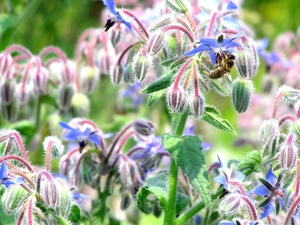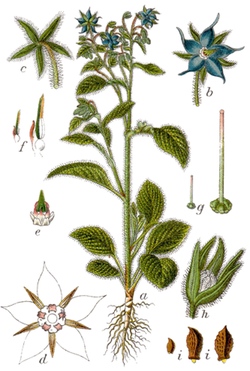Borage Characteristics
(Borago officinalis)

Name Origin:
The name borage is thought to have come from a corruption of cor, the heart because of its former use as a cordial or heart-fortifying medicine. Courage is from the same source.
Another theory is that is comes from borrago, which means rough and relates somewhat to birrus, a thick coarse woolen cloth worn by the poor during the thirteenth century. Yet another source said the original common name was “burrage” or “llanwenlys” a Welsh word for “Herb of Gladness.”
Natural Order:
unplaced
Growing Cycle:
Annual Herb, freely reseeds
Origins:
The plant is a native of the Mediterranean Europe and Africa.
Height:
2 – 3.3 feet (60 – 100 cm)
Appearance:
Hairy stems and leaves with flowers forming on long stems.
Borage Flowers:
Flowers can be blue, pink or white with blue being the most common with distinct black anthers. Star-shaped flowers have 5 narrow, pointed petals.
Borage flowers and bees work well together. When the flowers first bloom they are generally blue. Once pollinated, they turn purple and then pink. Bees can’t see shades of red and often can’t distinguish between red flowers and the green leaves around them (more info on bees and color from the West Mountain Apiary). It would seem that borage plants therefore encourage bees to visit un-pollinated flowers and not waste their time visiting flowers that have already been pollinated.
Borage Growing
(Seeds, sowing, and harvesting)
Borage plants prefer full sun to partial shade and generally bloom throughout the growing season. They do have hollow stems and therefore might need more water. If leaves are drooping or curling, your borage is thirsty.
Growing Borage From Seeds

Borage will grow in most soils but does best in light, well-draining soil. Borage, like most plants with a single taproot, isn’t fond of being moved, so sowing early indoors may produce mixed results. Seeds can be sown in early spring once the ground is warm or in patio pots. The seeds should be planted about half an inch deep in drills that are spaced 10-12 inches apart. Borage seeds tend to have a high germination rate, so sow thinly. Seeds are also said to be viable up to 8 years. You can ensure a ready supply of leaves and flowers, by sowing borage seeds throughout the growing season.
Borage can be a prolific self-seeder. But, the good news is that their single tap root make them fairly easy to remove or thin.
Harvesting Leaves and Flowers
Borage plants have hollow stems – damage those stems too much and your plant may rot and die. That means you should be careful harvesting leaves, flowers and seeds.
I’ve seen suggestions to eat young leaves and other suggestions to wait until the leaves mature. But, the best advice I saw was to harvest only a portion of each leave to help ensure the stem is not damaged.
Borage flowers should be harvested by gently separating the flower petals from their green bases.
We haven’t added borage to our own herb garden yet but since it blooms all season, I suspect it might produce seeds all season as well. I’m thinking it might be a good idea to harvest the seeds by leaving the seed pods on the plant and gently shaking the seeds into a bag or bowl. If you need borage seeds, Ohio Heirloom Seeds offers packets of 200 seeds on Amazon.
Culinary Uses of Borage
(leaves, flowers and seeds)
For the most part, borage is grown as an ornamental herb. However, one of the most famous uses of borage is that it is one of the botanicals (juniper, sage, borage, lime (fruit) and bitter orange) used in the making of Gilpin’s Westmorland Extra Dry Gin. It is also used in the German green sauce known as Grüne Soße or Grüne Sosse.
Leaves.
I’ve seen several places mention eating the leaves but the prickly hairs that cover borage make me wonder how the leaves would feel in your mouth. The entire plant is said to carry the scent of cucumber and the stems and leaves taste like cucumbers. I did see one source that said some folks cook borage leaves like spinach or even with spinach – no word on if that softens the hairs or not.
Flowers.
Borage flowers do seem to offer a better option for eating than the leaves. They have a sweet honey-like flavor, without the hairs. Fresh borage flowers can be added to salads; frozen in ice cubes for a pretty, refreshing summer addition to drinks; or crystallized in sugar as a pretty cake decoration.
Borage Seed Oil.
While not a culinary use, borage seed oil is used for a number of medicinal purposes. It contains a fatty acid called gamma-linolenic acid (GLA) which seems to have anti-inflammatory effects.
Warning from WebMD
Some borage-based products contain hepatotoxic pyrrolizidine alkaloids (PA). They list borage with PA as “likely unsafe” for ingestion by mouth.